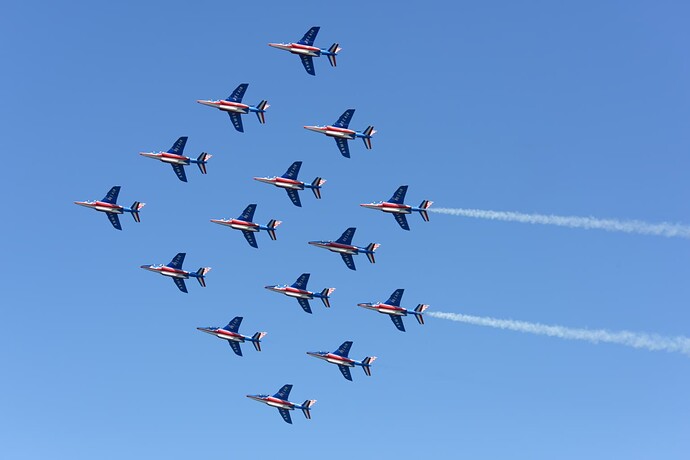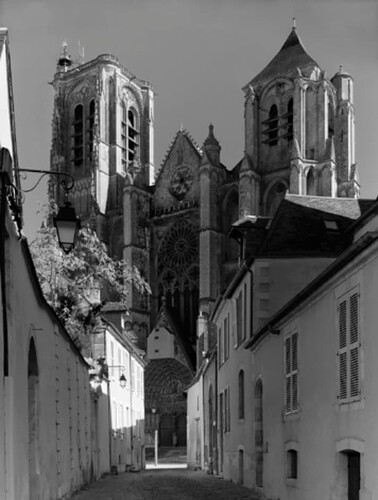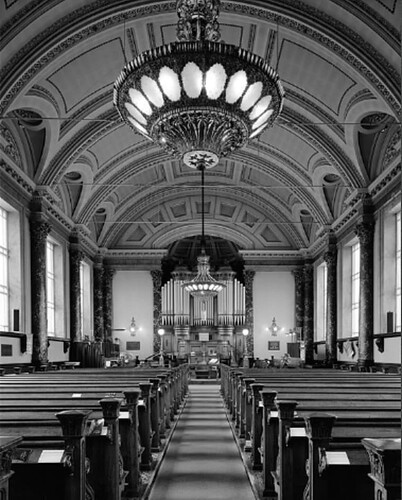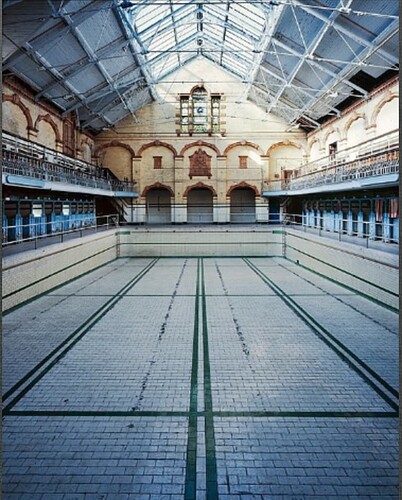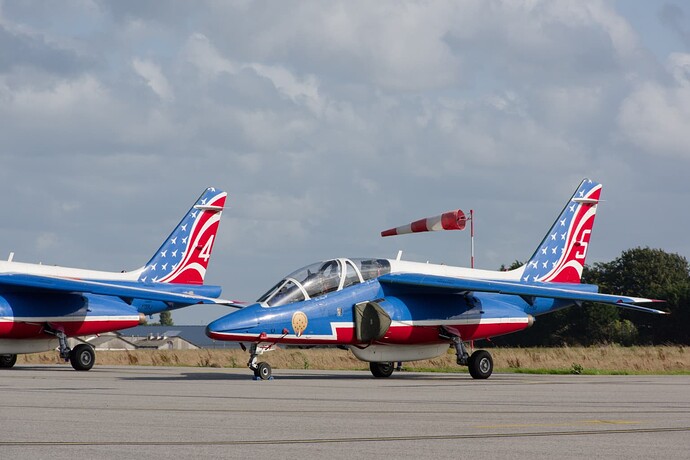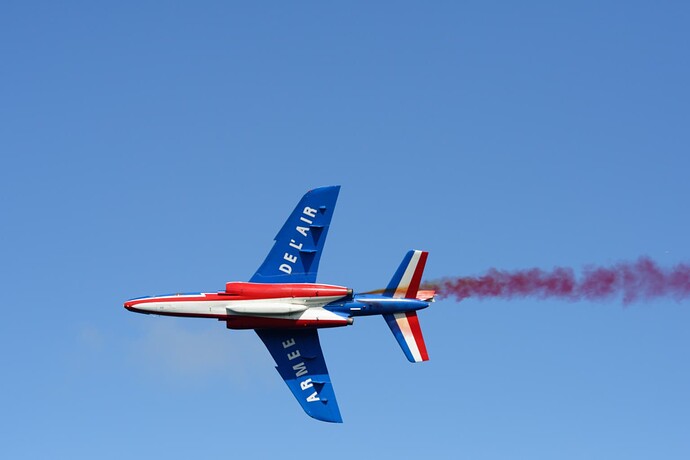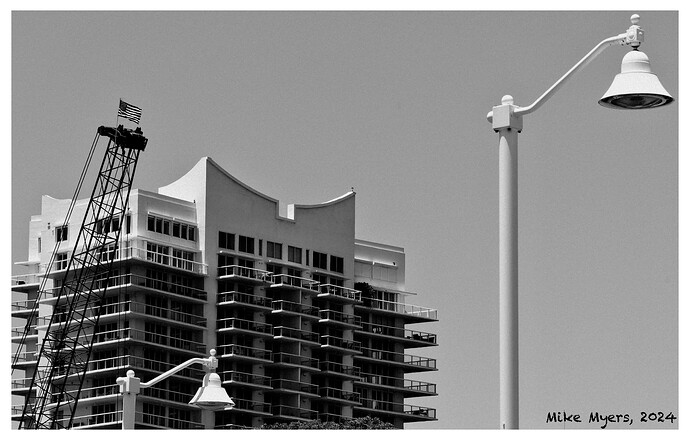Hello Mike,
That’s a B-1B “Lancer” bomber with sweptwing capability ![]()
Google on ‘manipulated iconic photos’. You’ll see a lot but I miss a lot too.
The Russians manipulated images to rewrite/correct the past.
A Dutch example was a photo of an army truck in Afganistan. It won the third price I believe. But then they discovered it was manipulated and the photographer lost his price.
It’s in Dutch so you have to use Google Translate or Deepl.
George
Don’t worry. Neither of us are interested in entering competitions, which are usually a means for organisations to glean cheap images for themselves to use in publicity or on their websites.
Well, I’m sorry but this was a bit blatant.
So, what is the situation if you had used a large format camera with movements to correct the distortions that the camera angle gave you? Or if you had used a tilt/shift lens on your D780 to obtain the same distortion corrections in camera. Are these manipulations of the image? Does it make the image any less a photograph, even though the correction was done in the camera and existed on the original negative?
Let’s look back to when photos, especially newspaper photos, were taken on B&W film. How is that being “truthful”? Surely the world is in colour so, by attributing various shades of grey instead of colours, we are not “telling the truth”
Then there is the use of different film emulsions, chosen for their B&W rendering - orthochromatic, panchromatic, infra-red, etc. Which one is the truth? Can any B&W rendering ever be described as being “true”?
Moving on to colour film. Which emulsion tells the truth? Daylight colour temperature film; tungsten colour temperature film; Fuji Velvia 50, which is hyper saturated; Fuji Velvia 100, which is less saturated; Fuji Astia 100, which is fairly neutral; negative colour films which have to be interpreted at the printing stage because they have an orange base, depending on the make of film???
No, there is no such thing as a “true” photograph. Even framing to exclude things that surround the subject is a form of editing. In fact, all means of recording “reality” in a limited two-dimensional area could be said to failing to record “reality”
Take the estate agent’s photo of a house we went to see when we were looking to move over here. It showed this perfectly lovely cottage, with an idyllic garden and, having been to see the cottage, I can tell you it had not been manipulated… or had it? When we did get there, we found it was in the heart of a pig farm, with a silage pit within 50 metres of the front door and a couple of hundred porkers grunting away in the nearby sheds. Needless to say ,we didn’t even get out of the car and when asked by the agent if we would like to see inside the house, our answer, through a barely open car window was simply “Why would we want to?”
So, from the moment you choose what to photograph, you could be said to manipulating the image.
And this, Mike, is the bare bones essential of your self-imposed definition. The majority of photographers, who market photographs, which people call photographs and buy as photographs, are not doing so for the purpose of journalistic integrity. Mike, do yourself a favour and, in your retirement, let go of such paranoid restrictions and get on with making images that are as beautiful as your building shot.
Only if you allow the software so to do. The purpose of the retouch tools that PhotoLab provides is to allow you to get rid of something that would otherwise spoil the aesthetic of an otherwise beautiful image - something that, had you had the appropriate tools with you, you would have physically removed to take the shot. And it doesn’t invent anything - it simply takes another part of the same image and covers up the offending object, blending in when you use the repair tool instead of the clone tool.
Take this shot of a wreck - can you tell it has been manipulated? If so what has been changed? Would you have bought the print if it contained the offending intruder?
In fact Photoshop also lets you choose the source for cloning or repairing, long before AI came long.
As @mwsilvers said, what you did was impose a horrendous blur over the image, which attracted the eye even more strongly than the original vehicles.
On the other hand, how many planes were the Patrouille de France flying on this day?
The answer is eight but, thanks to PhotoLab, the French government didn’t have to spend even more of our taxes ![]()
Don’t be so sure about the “obviously” part. And with the “improvements” in AI, it is becoming increasingly difficult to tell what is fake or not.
As to perspective, can you tell which images have had movements applied to correct converging verticals?
The answer is all of them. All done in camera but easily reproducible in PhotoLab had I not used movements.
![]() And was taken by your incredibly versatile 28-300, so that the plane-IDs are blurred thanks to the outstanding resolution, not impacted by Topaz refinement and downsized to “I can see some markings, but not read them”? Clever you!
And was taken by your incredibly versatile 28-300, so that the plane-IDs are blurred thanks to the outstanding resolution, not impacted by Topaz refinement and downsized to “I can see some markings, but not read them”? Clever you! ![]() [/irony]
[/irony]
To add my irrelevant opinion to the next “typical Myers” pointless discussion: There’s no truth in any photograph - except that it truly is a photograph. As every image is only a cropped frame of a bigger picture and a very short moment which is a crop of a timeline. Before and after can happen another “true incident”, so don’t stress your brain whether it is true or not and use the saved energy to compose and get a good vantage point.
Actually, I do enjoy composed (and not by AI altered) images a lot, like the famous “elephant in the room”. Some people are gifted to give us a picture of our often poorly imagery of language.
I have had a problem since day one of my digital photo days to understand the debate of “manipulated pictures”,
The fact is that either the camera itself or our converters affects pictures in one way or the other with all sorts of profiles for cameras and lenses.
On top of that who can tell exactly were the limits are for not offending the concept of “not manipulated” with pulling a slider a bit too much or as some prefer to say these days “documentary”.
I consider all my pictures as “manipulated” the photo purism has always been a dead end for extremists that like extremely religios people love to constrain themselves in order to feel a little bit better than the rest of us.
Exactly, @Stenis ! I used to think “manipulation” is something bad, always done to betray others. Then I learnt the term “manipulator” as the artificial robotic arms used to handle dangerous substances.
And the origin is explained in Wikipedia:
Substantivisation of the verb manipulate
borrowed in the 18th century from French manipulation “handling” (connotative but same meanings as in German); this comes from French manipule “a handful”; this from Latin manipulus; initially denoted a handling or treatment with a handful of herbs or substances; from manus “hand” and plere “to fill, fill”[1]
Later it became a bad connotation.
An unmamipulated photograph is just a silver plate in a black box with a tiny hole in front of the plate, being corroded by the influence of light. The lens in front of it already is manipulation, any other chemicals to get the process done quicker another manipulation. Therefore this discussion about truth of photographs is very silly and pointless.
Heheheh. Actually, that was taken with my 80-400 on the D810. Fortunately, for the purposes of cloning, the only IDs were on the tail fins…
But the 80-400, at 185mm is great for those “intimate” shots where the plane is pulling a turn, almost overhead…
unretouched and uncropped ![]()
I love it ![]()
Now, this is absolutely brilliant!
Oh, by the way, another manipulation that purists forget about B&W photography is the use of coloured filters to balance out and redistribute tonalities in an image, which would otherwise just be a mass of the same, or similar, grey tones.
And thank you for that clarification. I hadn’t thought of the effect that the lens has. Think of the plastic Holga lens or Cooke lenses that are designed to give vignetting, soft focus, distortion, etc. And for a time in photographic history, all you could get was poor quality glass - unless you took pinhole shots, which of course, suffered from diffraction ![]()
Hey, this is great! You’ve just reminded me of the fact that the human eye only ever sees a small field of view at one time. It is the brain that combines all those “snapshots” together. I read that the “truly sharp 3D” angle of view is only around 6° but our amazing brain is continually refocusing and combines all those sharp areas and convinces us it is all sharp.
Finally, what about the photos that we’ve more than likely all taken, where we’ve (re)moved stuff before taking the shot? ![]()
Not to mention all studio shots with all available “little helpers”. No one ever asked painters to do “true paintings/drawings” or cave people to make true coal drawings of the yummy mammoths. “Truth” in a man made image is an illusion.
Which also brings to mind the use of lighting or flash. Surely, that is manipulation? Without such artificial aids, we would not have certain images but I have never seen such an image disqualified. Now, of course, we have high ISO sensors, so the “purists” can vent their spleen on whether noise reduction is a manipulation or just a correction for the failings of the sensor ![]()
IF you had understood …
You are picking a pic (again out of context), which demonstrates how the one (!) vertical line turns the image, so that the railing appears strictly vertical (alongside the grid). And it has nothing to do with your (our) perception.
I learn my son yesterday night about the power of time vs noisy highiso grab a shot.
Set my / his fz200 to manualmode, and showed him the -3…0…+3 exposure graphic. Let him turn Aperture to smaller numbers. (smaller is bigger hole is the first bump his brain needs to grasp.)
And the magic of the 2" is 2 sec and 250 is 1/250sec is the second bump in grasping triangle. And showed him the result of a dark shot in a balanced exposure. The marker on “zero” in the middle.
He asked me how did he know it’s propper exposed?
I responded just take 1 or 2 shots around your first gues and your should be fine.
Use Pmode wile snapping and walking with your group, your camera is at this moment smarter in this then you.
Take some time to understand aperture and sharpnes, dof
Downloaded photograper companion for him and said have fun!
If 50% of his taken images are alright i am happy.
IF you had understood …
The length of the lines doesn’t play a role for the perspective. The length is “adjustable” for convenience / so that you can easier control the angle of modification.
About the “name tag” you say I used - where is that?
You are not color blind, are you?
In most of the responses up above, people are talking about “pictures” or “images”, which is not relevant to the question of what is a “photograph”.
The “photojournalism” rules only apply to images used for photojournalism, and they came about to help people trust what they were seeing. As has been pointed out, they don’t apply to this forum.
There are many discussions here, but my point was only, specifically, about “photograph”.
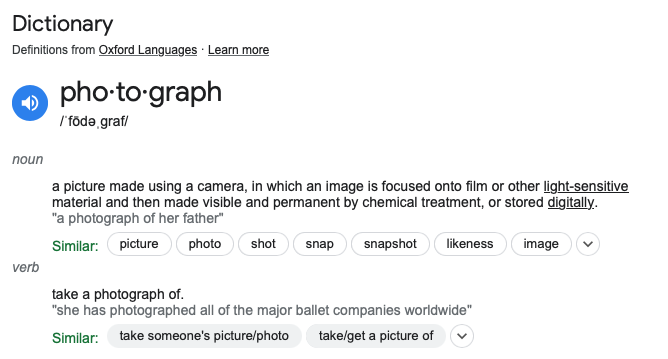
Obviously, digital manipulation can create a stronger image, correcting any flaws in the original, or to promote a point of view, and equally obviously, anyone and everyone can come up with their own definition, but once a photograph is manipulated, to me, strictly speaking, it is no longer a “photograph”.
I’m sure there are exceptions, but the dictionary definition works for me, especially in places like this forum.
sorry, now you get silly – if I may say so
Hello Jeroen, and welcome to this forum. If you found that photo in this discussion, am I correct to think you’re also a photographer?
B-1B Lancer… and thanks to you, I now understand why the wings looked so strange to me… “sweptwing”… I will do a search for this later. It really shocked me, so huge, so loud, and so close t me, and completely unexpected - I would have been no less shocked had it been a UFO Flying Saucer!!
I would prefer “specific” rather than “silly”, but that’s just me.
What is your definition of a “photograph”?
Yes, thank God the world is not uniform. …
Make use of the included dop-file and put it together with your original raw-file in a separate folder. Before you start to manipulate, add another virtual copy to keep the source version intact.
Check what I did (e.g. Tone Curve, Color Rendering, Channel Mixer) and copy the relevant settings only to a virtual copy of your pic / image / photograph (whatever you will call it).

Of course it doesn’t work 1:1 and you have to adjust your settings. But that’s how you learn.
What kind lens one puts on a camera is irrelevant - whether the lens be a fisheye, or a piece of plastic, or a tilt/shift mechanism, what comes out of the camera (analog or digital) is then the photograph. Whether the image is realistic, or distorted, or tilted, is irrelevant. It is still a photograph.
Much of this discussion is about the “image”, which is certainly improved by removing stuff that one did not want in the finished picture, or in the darkroom or computer. That creates an image (picture). If the person is talented, that picture may look much better than the original photograph (as with Ansel Adams), but the actual “photograph” is what came out of the camera. Manipulation in the darkroom or computer likely creates a far better “image” (picture). None of that other stuff affects the dictionary definition of “photograph”, and all that additional manipulation can/will have a huge effect on the end result.
As to realism, that is a different discussion. Lenses can compress space, or expand space, or create a “fisheye” result. The fact that the image is still a photograph does not prove the image is what we call “realistic”.
This is a quickly-taken view of Miami, using my 14mm Sigma lens. (It also tells me I wasn’t holding the camera level.) It certainly is NOT what people think they see from my balcony, and Sigma went to a lot of effort to make it a “normal” (non-fisheye) image, but by definition, even though people would say it is not realistic, it is still a photograph (although I’m not certain what PhotoLab did to the image, behind my back, even though I did no editing other than to export it as a jpg image).
780_5427 | 2024-05-27.nef (27.3 MB)
780_5427 | 2024-05-27.nef.dop (12.8 KB)
Simple - call it an edited photograph, or an image, or a picture. Technically, photograph means what came out of your camera, before you modified it. 99.99% of the people who might see the image would not know, or care.
Or, write the dictionary publishers, and get the definition updated. Or just ignore all this, since nobody else seems to care anyway. Or, flip a coin - heads it’s a photograph, and tails it’s a picture.
Of course, this forum is about PhotoLab, and how we can best edit our photographs.
…and then again, in today’s age, most people no longer trust “photographs” anyway.
Yesterday morning I went out early, before the heat attacked Miami, to go food shopping. I debated bringing my camera or not, an took it with me.
I found four things that intrigued me, and tried to capture each of them. While walking home, I saw a strange scene way off in the distance. I tried to convince myself it wasn’t worth photographing, but some part of me insisted, so I took several slightly different images, each one coming out better.
I started to edit it several times, using PhotoLab tools, and FilmPack tools. I used FilmPack to put a black frame around the image, but for reasons I don’t understand, the exported image did not include the black frame, and used a white frame, but that’s OK. I was mostly having fun, and learning, by trying new things.
Whether it deserves to be posted here or not, I’m not sure. Since it intrigued me, maybe that’s a good sign, or maybe it’s a sign that I had been out in the hot sun too long. It’s not accidental everything that got included or excluded was deliberate. I’m most curious as to what Joanna will say - perhaps she’ll like it, or perhaps she will tell me to put my camera away for a while…
780_5240 | 2024-05-26.nef (29.7 MB)
780_5240 | 2024-05-26.nef.dop (27.1 KB)

